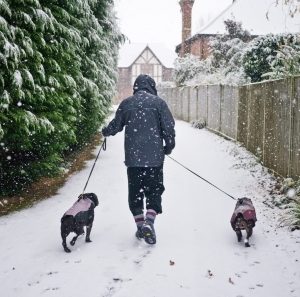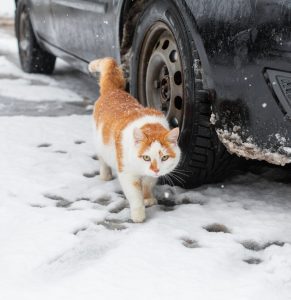How to Keep Your Pets Safe This Winter
December 2, 2021
It’s that time of year again! The holidays are here and, as always, along with them comes the cold weather. Here are a few tips to keep your pets safe when the snow starts falling and temperatures begin to drop this winter:
Keep warm & cozy
Staying inside during cold weather is an important part of keeping your pet safe this winter. It’s a common belief that a pet’s fur coat makes them resistant to the cold weather, but this is not true. Just like us, our cats and dogs are susceptible to frostbite and hypothermia and should be kept inside. Keep your pet’s outside time short and supervised. Also, remember cars rapidly cool down in cold weather and can act as a refrigerator, posing a significant risk to your pet. Limit car travel to only that which is necessary, and don’t leave your pet unattended in the vehicle.
Know your pets needs
Different pets have different needs when the cold weather hits. Things that impact an animal’s tolerance to cold are their age, health, coat, body fat stores, and activity level. Pay attention to your pet’s tolerance for cold and keep an eye out for signs that your pet is uncomfortable.
Activity level– You will probably need to shorten your dog’s walks in very cold weather to protect you both from weather-associated health risks. Even dogs who typically love to play ball for hours on end will need to have their outside time limited to make sure they aren’t overdoing it or exposed to the elements for too long.
Age/health status– Pets with diabetes, heart disease, kidney disease, or hormonal imbalances (such as Cushing’s disease) may have a harder time regulating their body temperature and may be more susceptible to problems from temperature extremes. The same goes for very young and very old pets. Arthritic and elderly pets may have more difficulty walking on snow and ice and may be more prone to slipping and falling.
Size– Smaller and short-legged pets may become cold faster because their bellies and bodies are more likely to come into contact with the snow-covered ground or frigid water.
Coat– Long-haired or thick-coated pets tend to be more cold-tolerant, but are still at risk in cold weather. Short-haired pets feel the cold faster because they have less protection.
Look for signs of hypothermia & frostbite
If your pet is whining, shivering, seems anxious, slows down or stops moving, seems weak, or starts looking for warm places to burrow, get them back inside quickly because they are showing signs of hypothermia. Frostbite is harder to detect, and may not be fully recognized until a few days after the damage is done. If you suspect your pet has hypothermia or frostbite, consult your veterinarian immediately.
Take a second to check in after walks
Remember to check up on your pets after taking them out to see the beautiful snow. Having playtime in cold weather is fun for humans and pets but it is important to make sure your animals are healthy after doing so.
Check paws- Check your dog’s paws frequently for signs of cold-weather injury or damage, such as cracked paw pads or bleeding. During a walk, a sudden lameness may be due to an injury or possibly due to ice accumulation between their toes. You may be able to reduce the chance of ice accumulation by trimming the hair between your dog’s toes.
Clean up time- During walks, your dog’s feet, legs, and belly may pick up de-icers, antifreeze, or other chemicals that could be toxic. When you get back inside, wipe down or wash your pet’s feet, legs, and belly to remove these chemicals and reduce the risk of poisoning if your dog licks or grooms themselves.
Keep an eye out for community cats
Most communities, especially in urban or suburban areas, have “community cats,” outside cats that may be feral or may not have a specific owner and roam between feeding/resting locations. Animal lovers should keep an eye out for community cats during bad weather to make sure they are safe and have shelter.
Engine safety- During cold weather, a warm vehicle engine can seem like a good heat source to outdoor or feral cats, but it can be deadly! Cats that hide in cars for warmth can suffer from severe burns, loss of limbs, and even death if the engine gets started while they are hiding in there. Before starting your engine make sure to check underneath your car, bang on the hood, and honk the horn- that should encourage any hiding cat to leave their spot under the hood.
Shelter- Feral and outdoor cats will be on the lookout for safe, warm shelter during cold weather and winter storms. You can help outdoor cats be safe and healthy by offering shelter that is well insulated, has minimal air space, and is waterproof. There are many different guides and plans available online for inexpensive, DIY shelters that can be built in a matter of hours or less- check them out here!
License your pets!
Many pets become lost in winter because snow and ice can hide recognizable scents that might normally help your pet find their way back home. Make sure your pet has a well-fitting collar with up-to-date identification and contact information. Microchips are a more permanent form of ID, but it is important to make sure the registration with your contact info is kept up to date. KHS sells personalized and engraved pet ID tags for just $6.
By taking these tips and tricks into account, you and your pets are set to have a safe and warm winter. Happy Holidays!




